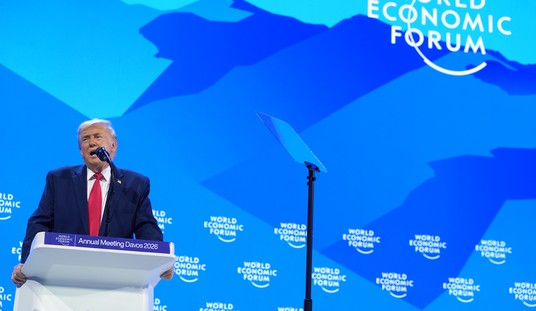Fox can fire its pollster for the endless string of discouraging data it’s produced for the president or it can defend its pollster as a highly regarded member of the profession.
But it has to be one or the other. As a matter of basic integrity, the anchors can’t sit by in silence and let White House mouthpieces like Hogan Gidley try to gaslight the audience about “fake polls.” Either agree with him and terminate the in-house pollsters for being part of the “suppression poll hoax effort!” or push back. Brian Kilmeade, the most independent-minded member of the “Fox & Friends” crew, pushed back.
What’s got Gidley exercised? I’ll tell you after you watch.
On Fox & Friends, Trump campaign press secretary Hogan Gidley calls Fox News polling "fake," and Brian Kilmeade tells him "don't call the Fox News pollsters fake." pic.twitter.com/kV6xS1keEK
— Bobby Lewis (@revrrlewis) July 24, 2020
He’s grumbling because Fox dropped three new battleground polls yesterday, none of them good. The least bad is Minnesota, which Trump barely lost in 2016 and had been hoping to target this year as a way to hedge against a Biden upset in, say, Arizona. But at the moment POTUS is in no position to expand the map; he’s on defense not just in true swing states like the Rust Belt but in reddish swing states like Texas. Fox has him down 13 points in Minnesota, 51/38. Which is bad, but ultimately doesn’t change the 2016 map at all.
The bigger news is that they also have him down nine in Michigan and 11 in Pennsylvania, each part of the midwestern blue wall that he shattered four years ago. Together those two account for 36 electoral votes. Subtract them from Trump’s 2016 total and his lead over Biden would shrink to 270/268, with any other Trump state on the map capable of handing the presidency to the Democrat unless Trump can pick up a Clinton state somewhere — and like I say, Minnesota may be his best bet. The story in all three states is the same: Apart from Biden piling up huge leads with women, his overall advantage owes less to him running up the score with traditionally Democratic groups and more to him cutting into Trump’s lead with traditionally Republican groups. He polls well in Fox’s data among senior citizens and suburbanites, holds his own among men and whites without a college degree, and is even competitive with Trump on who’d best handle China.
Maybe most importantly, and contrary to conventional wisdom, Biden is the “enthusiasm” candidate right now. Gidley spends the clip insisting that Biden’s leads are a mirage because Trump has way more social media interaction or whatever, and certainly it’s true that Trump fans are more excited about their candidate than Democrats are about theirs. But that’s not the relevant issue with enthusiasm. The relevant issue is who’s more enthusiastic to vote. Is it Trump-lovers on the right or is it Trump-haters on the left who have zero use for Biden but are roiling to cast a ballot for him in the name of seeing Trump ousted? The Democrat has double-digit leads in all three states among people who are “extremely interested” in the election: He’s +10 in Michigan, +15 in Pennsylvania, and +27 in Minnesota.
Another piece of evidence about which side is more solidly behind their candidate is how each nominee polls among his own party. In all three states Biden does better among Democrats than Trump does among Republicans. In Michigan he’s +88 to Trump’s +82, in Pennsylvania he’s +83 to Trump’s +74, and in Minnesota, a bluer state, he’s +89 to POTUS’s +79. Turnout this fall will be a test not of which side most loves its nominee but of whether the right loves Trump more than the left loathes him.
Nate Cohn, the Times’s data guy, has a piece out today wondering what the total picture would look like on Election Day if Biden’s competitiveness for the white vote isn’t a mirage. If he produces the usual Democratic landslide margins among nonwhites but also runs up the score among white college grads (while holding Trump to something less than a landslide among whites without a degree), what sort of wipeout is the GOP looking at? Right now, notes Cohn, Trump’s lead among white voters overall is down to three points in quality polls. In 2016 he beat Hillary Clinton by 20 among that group.
Over the last two decades, Republican strength among white voters has given the party structural advantages in the House, the Senate and the Electoral College. A competitive race among white voters would deprive Republicans of those advantages, threatening carefully devised gerrymanders and raising the specter of previously unimagined losses in the Senate.
[I]n this situation, Mr. Biden would win by 10 percentage points, 54 percent to 44 percent, and would win 375 votes in the Electoral College, including all of the states won by Mr. Obama in 2012, in addition to North Carolina, Georgia and Arizona. Mr. Biden’s weakness among nonwhite voters would leave Texas short of turning blue…
Republicans in the House may also face severe consequences. In this analysis, Mr. Biden would carry a staggering 260 congressional districts, including a half-dozen districts won by Mr. Trump in Texas. He could even carry districts where Mr. Trump won by double digits in 2016, like Missouri’s Second, Indiana’s Fifth, Arizona’s Sixth, Florida’s 16th, or Ohio’s 12th and 14th. Mr. Trump would win another set of 25 districts by less than five points each. Many of these districts were only somewhat competitive in the 2018 midterms, while many others were not competitive at all. Already, various ratings outfits like the Cook Political Report have classified them as competitive.
That’s the real nightmare scenario this fall. It’d be bad but not disastrous for the GOP if Biden won but McConnell retained a Senate majority to curb him. It’d be disastrous but not paradigm-shifting if Dems won the White House and a *narrow* Senate majority since it’s likely that the GOP would strike back with big gains in the midterms and retake the upper chamber. There’d be two years of Democratic rule, but some Dems would be nervous about the extent of a right-wing backlash in 2022 if they went whole hog on a leftist agenda and might stick to the center. The paradigm-shifting scenario is if Democrats win so big this fall in the House and Senate that they actually end up with a cushion for the midterms, raising the possibility of unified Dem control all the way through Biden’s term. They could get a lot done in four years and they’d be less fearful of a Republican backlash in a presidential election year like 2024 than they would be in a midterm. If anything, progressives will push them to go big on policy reforms in the belief that Americans will come to like the new changes and will reward the party four years from now to keep them going.
Republicans had better get some of those wayward white voters back before November. At the moment, the Cook Political Report thinks it’s more likely than not that Democrats will retake the Senate majority. Even David Perdue’s Senate race in Georgia is now listed as a toss-up.
I’ll leave you with this from the Examiner’s Tim Carney, who laid the national polling trends in 2016 beside the trends in 2020 for comparison purposes. Hillary did have big leads at times on Trump four years ago, but every time she gained some distance on him she began to fall back towards a close race. This year the only question has been, “How big is Biden’s lead today? Sorta big or really big?”
The 2020 polls are not like the 2016 polls. https://t.co/UzNknAQuZL pic.twitter.com/0iO5im4aAF
— Tim Carney (@TPCarney) July 24, 2020









Join the conversation as a VIP Member